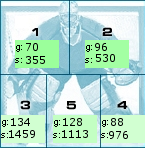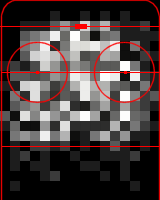“I do think that opposition and line matching makes a big difference. The biggest argument for that claim is that home teams win 55% of the time. That is a fairly significant advantage. And what is the biggest advantage that home teams get? A greater ability to match lines because the road team has to put their line on the ice first” (David Johnson). On first glance I agreed that 55% home win percentage is significant (this is constant over seasons with a range of about half a percent) should indicate that the ability to change last, the only significant difference given to home team, should give the home team this advantage. A further analysis shows that goal for increase by 10% at home and goals against fall by 10%. There appears to be two parts to this question: what increases scoring at home, what decreases goals against? It should be noted that goals for the home team equal goals against the away team. There were a total of 3986 goals accredited the home team (These include 1 extra goal for the worthless SOWer, but this wont be significant) and 3602 accredited to the away team for a total difference of 384 goals.
Before focusing on the possible differences I should state the NHL wants the home team to win, probably because if a new fan is in the stands of a win they’re more likely to return than if there’s a loss. So for example the average number of rest days for the home team is 2.4 days rest average and away teams have 2.2 average days of rest (back to back games are counted as 1 day rest). There is a similar home team favored schedule in 2005-2006 as well: 11% of home team’s games are back to back, where 26% of away team’s games are back to back.
Power Play.
It’s interesting to note that there are an additional 405 penalties given (only minors) to the away team (1/3 per game) (8199 vs. 7794), might sound like a little, but this should work out to around 60 goals. If you just look at the more subjective calls (the ones they can ignore) you get a more significant difference of 390 (6457 vs. 6067), which is a lot larger as a percentage. Interesting these power plays resulted in 1382 power plays goals for home and 1162 for the away team (difference of 220), which suggests this problem is a little more complicated. A way a referee can get the home team more goals without giving more penalties is to give them a little closer together so as to result in “5 on 3”s. The home team scored 266 “5 on 3” goals vs. 189 “5 on 3” goals for the away team. There’s really no good reason for this, because each team will be playing their best available. This accounts for 77 of the 220 (leaving me with 143, when I would only expect 60). One could argue that strength of opposition can affect whether a player takes a penalty. Whether this is mandated by the NHL or simply the result of the fans would be hard to determine unless a ref outright stated it to the media, but either way the home team is getting a lot more “5 on 3”s (or scoring with them at much high rate).
The Backup
On the surface most people wouldn’t expect this to be a factor, but teams want to give a good show to the home team so when possible teams shift their secondary goaltending into away games. In fact the ratio of home to away is quite significant as the backups play 20% more games away then at home for about 3 extra games away than at home (there's a large variation between teams due to the fact it's hard to write an algorithm that picks the #1 goaltender). If you consider the backups save percentage to be 1.5% (.905 vs. .890) worse than a primary goalie and consider there are about 100 shots on goal for the backup away vs. at home in those three games, or about 1.5 goals per team or 45 goals over the course of the season (Approximately 15 on the power play and 30 at even strength). It’s interesting that
Even Strength
If the strength of opposition was significant, it should be most significant at even strength. There’s a 145 goal differential favoring the home team (or 6% difference), of course I brush this aside by stating the standard deviation of goals is 50 (±100) and if you compared these two distributions simultaneously you’d see no significant difference (73 < style=""> Of course 30 of these 145 can be accounted with goaltending alone (30 * 2 due to the fact that removing goals for from the home team lowers the goals against for the away team), reducing it to 85 (which is within one standard deviation of a mean of 50%) or 3.8%. This would result in a 51.8% winning percentage for the home team, which I wouldn't consider near as significant as 55%.
Difficult to Quantify
Of course this doesn’t cover aspects such as knowledge about your ice, sleeping in your own bed (positive or negative?) also one should consider Travel, which I’ve never seen had an affect on winning percentage. Players likely want to win for their home fans more than the away fans, they might plan a different style that results in more losses on the road (whether it’s logical or not).
Conclusion
To say there’s no such thing as line matching would be crazy, almost every coach attempts some protection and some abuse of players to maximize their goal differential, but whether this affects the outcome to a significant extent is rather subjective. Either way a 2% change in player scores would be indistinguishable from error and including the strength of opposition would likely make the model more complicated then the benefits of the added information. At this point it would be much more beneficial to be able to understand the dynamics of line mates rather than opposition as it would provide much more insight into the game. Also, If you consider that the time sheets have error (human error) in reporting ice time, strength of opposition would be near impossible to determine because the error would dominate the possible information.





